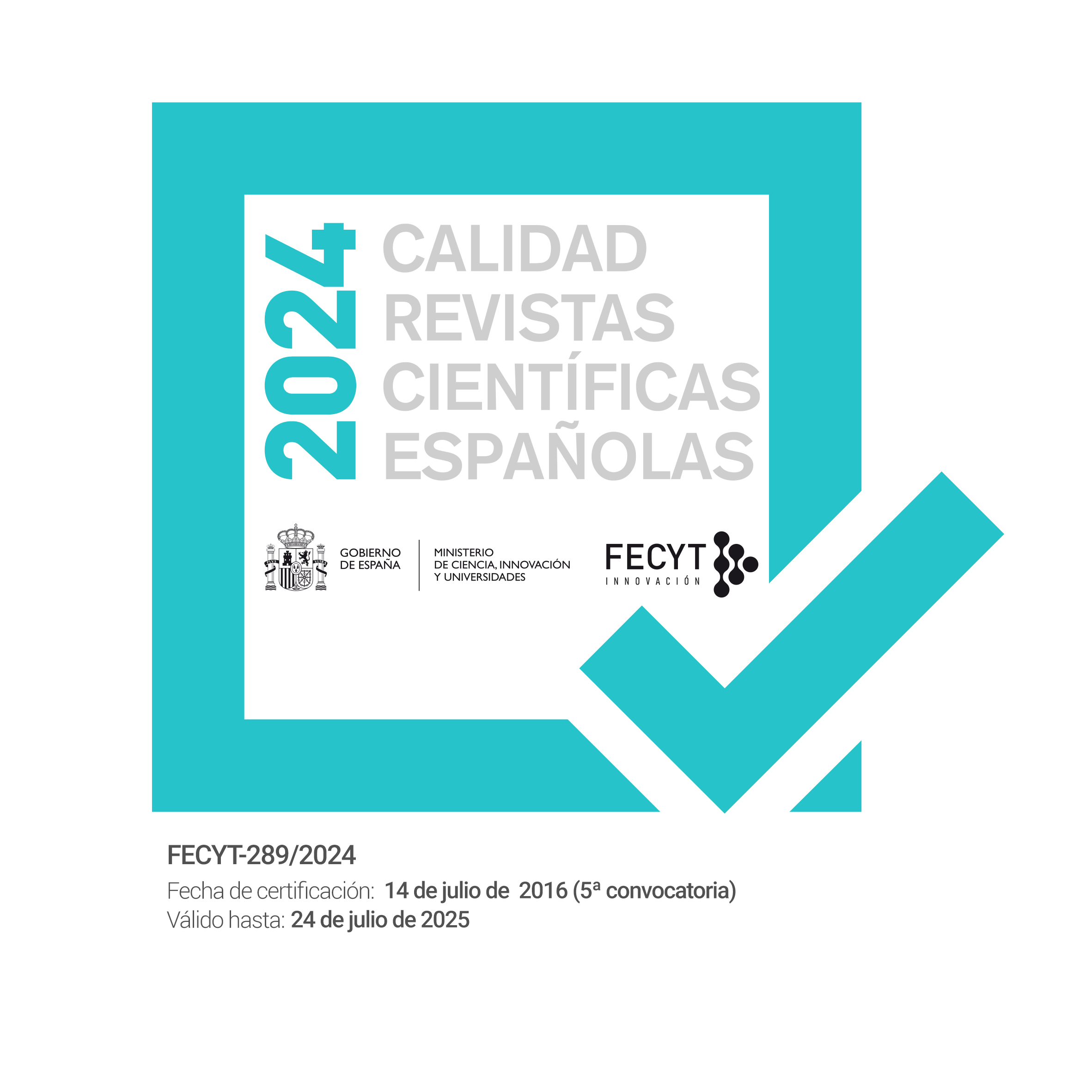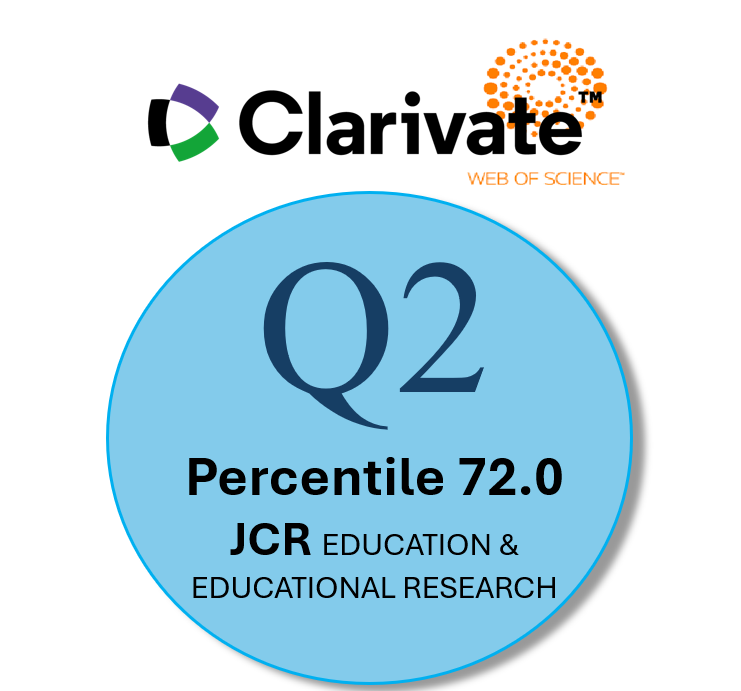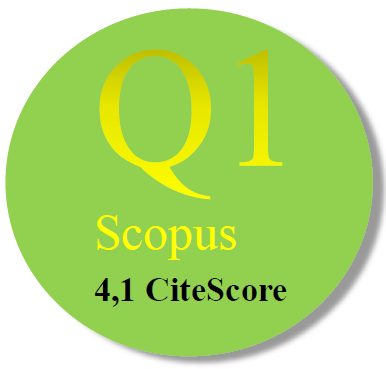Observational analysis of the development of computational thinking in Early Childhood Education -3 years old- through a proposal for solving problems with a ground robot with programmed directionality
Abstract
A sequence of problems of increasing difficulty is presented to develop computational thinking in the first level of the second cycle of Early Childhood Education -3 years- by means of a programmed directionality ground robot. With the use the observational methodology, it has been possible to characterize the computational thinking capacity of Early Childhood Education -3 years old- schoolchildren, in the different problems that make up the intervention proposal designed. The reliability of the data has been guaranteed, in the form of inter-observer agreement, by means of the Cohen's Kappa coefficient. A generalizability analysis supports the observational sampling carried out. The development of the capacities of spatial organization and self-evaluation of the student, as well as the intervention of the teacher, have been revealed as key aspects in the resolution of mathematical problems through computational thinking in Early Childhood Education -3 years old-.
Downloads
References
Aho, A.V. (2012). Computation and computational thinking. The Computer Journal, 55(7), 832-835. https://doi.org/10.1093/comjnl/bxs074
Allison, P.D. y Liker, J.K. (1982). Analyzing sequential categorical data on dyadic interaction: A comment on Gottman. Psychological Bulletin, 93, 393-403. https://doi.org/10.1037/0033-2909.91.2.393
Anguera, M.T. (1979). Observational Typology. Quality & Quantity. European-American Journal of Methodology, 13(6), 449-484. https://doi.org/10.1007/BF00222999
Anguera, M.T. (2003). La observación. En C. Moreno Rosset (Ed.), Evaluación psicológica. Concepto, proceso y aplicación en las áreas del desarrollo y de la inteligencia (pp. 271-308). Sanz y Torres.
Anguera, M.T., Portell, M., Chacón-Moscoso, S., y Sanduvete-Chaves, S. (2018). Indirect observation in everyday contexts: Concepts and methodological guidelines within a mixed methods framework. Frontiers in Psychology, 9:13. http://dx.doi.org/10.3389/fpsyg.2018.00013
Anguera, M.T., Portell, P., Hernández-Mendo, A., Sánchez-Algarra, P., y Jonsson, G. K. (in press). Diachronic analysis of qualitative data. En A.J. Onwuegbuzie y B. Johnson (Eds.), Reviewer’s Guide for Mixed Methods Research Analysis. Routledge.
Avello, R., Lavonen, J., y Zapata-Ros, M. (2020). Codificación y robótica educativa y su relación con el pensamiento computacional y creativo. Una revisión compresiva. RED. Revista de Educación a Distancia, 20(63). https://doi.org/10.6018/red.413021
Bakeman, R. (1978). Untangling streams of behavior: sequential analysis of observation data. En G.P. Sackett (Ed.) Observing Behaviour, Vol. II: Data Collection and Analysis Methods (pp. 63-78). University Park Press.
Bakeman, R. y Quera, V. (1995). Analyzing interaction: Sequential analysis with SDIS and GSEQ. Cambridge University Press.
Barron, B., Cayton-Hodges, G., Bofferding, L., Copple, C., Darling-Hammond, L., y Levine, M. (2011). Take a Giant Step: A Blueprint for Teaching Children in a Digital Age. The Joan Ganz Cooney Center at Sesame Workshop.
Belasko, M., Herrán, E., & Anguera, M.T. (2019). Dressing toddlers at the Emmi Pikler nursery school in Budapest: caregiver instrumental behavioral pattern. European Early Childhood Education Research Journal, 27(6), 972-887. https://doi.org/10.1080/1350293X.2019.1678928
Bers, M. (2008). Blocks, robots and computers: Learning about technology in early childhood. Teacher's College Press.
Bers, M. (2018). Coding as a Playground: Programming and Computational Thinking in the Early Childhood Classroom. Routledge.
Bers, M., Flannery, L., Kazakoff, E.R., y Sullivan, A. (2014). Computational thinking and tinkering: Exploration of an early childhood robotics curriculum. Computers & Education, 72, 145-157. http://dx.doi.org/10.1016/j.compedu.2013.10.020
Bers, M., González, C., y Armas, U. (2019). Coding as a playground: Promoting positive learning experiences in childhood classrooms. Computers & Education, 138, 130-145. https://doi.org/10.1016/j.compedu.2019.04.013
Cejka, E., Rogers, C., y Portsmore, M. (2006). Kindergarten robotics: Using robotics to motivate math, science, and engineering literacy in elementary school. International Journal of Engineering Education, 22(4), 711-722.
Clements, D.H. y Sarama, J. (1997). Research on Logo: A decade of progress, 14(1-2), 9-46. https://doi.org/10.1300/J025v14n01_02
Cochran W.G. (1954). Some methods for streghning the common χ² test. Biometrics, 10, 417-451.
Cohen, J. (1960). A coefficient of agreement for nominal scales. Educational and Psychological Measurement, 20, 37-46. https://doi.org/10.1177/001316446002000104
Cronbach, L.J., Gleser, G.C., Nanda, H., y Rajaratnam, N. (1972). The dependability of behavioral measurements: theory of generalizability for scores and profiles. Wiley.
Denis, M. (2017). Space and spatial cognition: A multidisciplinary perspective. Routledge.
Diago, P. D., Arnau, D., y González-Calero, J. A. (2018). La resolución de problemas matemáticos en primeras edades escolares con Bee-bot. Matemáticas, Educación y Sociedad, 1(2), 36-50.
English, L.D. y Watters, J.J. (2005). Mathematical modelling in the early school years. Mathematics Education Research Journal, 16(3), 58–79. https://doi.org/10.1007/bf03217401
Fessakis, G., Gouli, E., y Mavroudi, E. (2013). Problem solving by 5-6 years old kindergarten children in a computer programming environment: A case study. Computers and Education, 63, 87-97. http://dx.doi.org/10.1016/j.compedu.2012.11.016
Gabin, B., Camerino, O., Anguera, M.T., y Castañer, M. (2012). Lince: Multiplatform sport analysis software. Procedia Social and Behavioral Sciences, 46, 4692-4694. https://doi.org/10.1016/j.sbspro.2012.06.320
Giaconi, V., Perdomo-Díaz, J., Cerda, G., y Saadati, F. (2018). Prácticas docentes, autoeficacia y valor en relación con la resolución de problemas de matemáticas: diseño y validación de un cuestionario. Enseñanza de las Ciencias, 36(3), 99-120. https://doi.org/10.5565/rev/ensciencias.2351
Hernández-Mendo, A., Blanco-Villaseñor, A., Pastrana, J.L., Morales-Sánchez, V. y Ramos-Pérez, F. J. (2016). SAGT: aplicación informática para análisis de generalizabilidad. Revista Iberoamericana de Psicología del Ejercicio y el Deporte, 11(1), 77-89.
Hernández-Mendo, A., López, J.A., Castellano, J., Morales-Sánchez, V., y Pastrana, J.L. (2012). Hoisan 1.2: Programa informático para uso en metodología observacional. Cuadernos de Psicología del Deporte, 12(1), 55-78.
Jiménez-Gestal, C., Berciano, A., y Salgado, M. (2019). Cómo trabajar la orientación espacial de modo significativo en Educación Infantil: implicaciones didácticas. Educación Matemática, 31(2), 61-74. http://doi.org/10.24844/EM3102.03
Kazakoff, E.R. y Bers, M.U. (2011). The impact of computer programming on sequencing ability in early childhood. En American Educational Research Association Conference (AERA), Louisiana: New Orleans.
Kazakoff, E.R., Sullivan, A., y Bers, M. (2013). The effect of a classroom-based intensive robotics and programming workshop on sequencing ability in early childhood. Early Childhood Education Journal, 41(4), 245-255. https://doi.org/10.1007/s10643-012-0554-5.
Lapresa, D., Gutiérrez, I., Pérez-de-Albéniz, A., Merino, P., y Anguera, M.T. (2020). Interacción profesor-alumno-tarea en un programa de desarrollo de capacidades motrices en un adolescente con TEA: un estudio de observación sistemática. Journal for the Study of Education and Development. Infancia y Aprendizaje, 1-33. Online first, https://doi.org/10.1080/02103702.2020.1802148
Lehrer, R., Giles, N.D., y Schauble, L. (2002). Children´s work with data. En R. Lehrer & L. Schauble (Eds). Investigating real data in the classroom: Expanding children´s understanding of math and science (pp. 1-26). Teachers College Press.
Manches, A. y Plowman, L. (2017). Computing education in children's early years: A call for debate. British Journal of Educational Technology, 48(1), 191-201. https://doi.org/10.1111/bjet.12355
Mazas, B., Gil-Quílez, M.J., Martínez-Peña, B., Hervás, A., y Muñoz, A. (2018). Los niños de infantil piensan, actúan y hablan sobre el comportamiento del aire y del agua. Enseñanza de las Ciencias, 36(1), 163-180. https://doi.org/10.5565/rev/ensciencias.2320
Pifarré, M. y Sanuy, J. (2002). La resolución de problemas entre iguales: incidencia de la mediación del ordenador en los procesos de interacción y en el aprendizaje. Journal for the Study of Education and Development. Infancia y Aprendizaje, 25(2), 209-225. http://doi.org/10.1174/021037002317417831
Pöntinen, S. y Räty-Záborszky, S. (2020). Pedagogical aspects to support students’ evolving digital competence at school. European Early Childhood Education Research Journal, 28(2), 182-196. https://doi.org/10.1080/1350293X.2020.1735736
Rogers, C. y Portsmore, M. (2004). Bringing engineering to elementary school. Journal of STEM Education: innovations and research, 5(3).
Sackett, G.P. (1980). Lag Sequential Analysis as a data reduction technique in social interaction research. En D.B. Sawin, R.C. Hawkins, L.O. Walker, & J.H. Penticuff (Eds.), Exceptional infant. Psychosocial risks in infant-environment transactions (pp. 300–340). Brunner/Mazel.
Sinclair, A. (2005). Las matemáticas y la imitación entre el año y los tres años de edad. Journal for the Study of Education and Development. Infancia y Aprendizaje, 28(4), 377-392. http://doi.org/10.1174/021037005774518983
Strawhacker, A. y Bers, M. (2015). “I want my robot to look for food”: Comparing Kindergartner’s programming comprehension using tangible, graphic, and hybrid user interfaces. International Journal of Technology and Design Education, 25(3), 293-319. http://doi.org/10.1007/s10798-014-9287-7
Sullivan, A. y Bers, M. (2016). Robotics in the early childhood classroom: learning outcomes from an 8-week robotics curriculum in pre-kindergarten through second grade. International Journal of Technology and Design Education, 26(1), 3–20. http://doi.org/10.1007/s10798-015-9304-5
Terroba, M., Ribera, J.M., Lapresa, D., Anguera, M.T. (2021). Education intervention using a ground robot with programmed directional controls: observational analysis of the development of computational thinking in early childhood education [Propuesta de intervención mediante un robot de suelo con mandos de direccionalidad programada: análisis observacional del desarrollo del pensamiento computacional en Educación Infantil]. Revista de Psicodidáctica, online first, 1-9. https://doi.org/10.1016/j.psicod.2021.03.001
Wing, J.M. (2006). Computational Thinking. Communications of the ACM, 49(3), 33-35. http://doi.org/10.1145/1118178.1118215
Wing, J.M. (2008). Computational thinking and thinking about computing. Philosophical Transactions of the Royal Society A: Mathematical, Physical and Engineering Sciences, 366(1881), 3717-3725. https://doi.org/10.1098/rsta.2008.0118
Zapata-Ros, M. (2015). Pensamiento computacional: Una nueva alfabetización digital. RED. Revista de Educación a Distancia, 46(4), 1-47. https://doi.org/10.6018/red/46/4
Copyright (c) 2021 Distance Education Journal

This work is licensed under a Creative Commons Attribution-NonCommercial 4.0 International License.
Las obras que se publican en esta revista están sujetas a los siguientes términos:
1. El Servicio de Publicaciones de la Universidad de Murcia (la editorial) conserva los derechos patrimoniales (copyright) de las obras publicadas, y favorece y permite la reutilización de las mismas bajo la licencia de uso indicada en el punto 2.
2. Las obras se publican en la edición electrónica de la revista bajo una licencia Creative Commons Reconocimiento-NoComercial-SinObraDerivada 3.0 España (texto legal). Se pueden copiar, usar, difundir, transmitir y exponer públicamente, siempre que: i) se cite la autoría y la fuente original de su publicación (revista, editorial y URL de la obra); ii) no se usen para fines comerciales; iii) se mencione la existencia y especificaciones de esta licencia de uso.
3. Condiciones de auto-archivo. Se permite y se anima a los autores a difundir electrónicamente las versiones pre-print (versión antes de ser evaluada) y/o post-print (versión evaluada y aceptada para su publicación) de sus obras antes de su publicación, ya que favorece su circulación y difusión más temprana y con ello un posible aumento en su citación y alcance entre la comunidad académica. Color RoMEO: verde.














